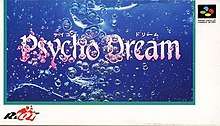Psycho Dream
Psycho Dream (サイコドリーム, Saiko Doriimu) is a 1992 video game for the Super Famicom. An attempt to release it in North America as Dream Probe failed; so it remained exclusively in the Japanese market.
| Psycho Dream | |
|---|---|
 Cover art | |
| Developer(s) | Riot (Telenet Japan) |
| Publisher(s) | |
| Designer(s) | Marino Nishizaki |
| Programmer(s) | Masayasu Yamamoto |
| Composer(s) | Michiko Naruke |
| Platform(s) | Super Famicom |
| Release |
|
| Genre(s) | 2D action platformer |
| Mode(s) | Single-player |
Unlike the developer's popular Valis series of video games, Psycho Dream's experience is focused primarily on the gameplay, and less on story.
Plot
In the early 1980s, rumors begin to circulate about a new entertainment medium called "D Movie," which allows people to immerse themselves in a world of virtual reality. As D Movies gain traction, a trend emerges of disaffected young people taking permanent refuge in the virtual world while abandoning their physical bodies to atrophy. To retrieve these so-called "Sinkers," Japan's National Public Safety Commission establishes Public Security Division Four (公安四課, Kōan Yonka), nicknamed "Diamond Dog" (ダイアモンドの犬, Daiamondo no Inu), in 1984. The agents who enter the virtual world and perform these rescues are known as Debuggers.
In 1992, a seventeen-year-old girl named Yūki Sayaka (柚木沙耶香) sinks into "Story of the Ruined Capital" (廃都物語, Haito Monogatari), a D Movie directed by David Visconti. Three days pass before she is discovered, and combined with her weak constitution, she is expected to die within twenty-four hours. Two Debuggers, Shijima Ryō and Tobira Maria, are dispatched to rescue her before that happens.
Gameplay
The player takes control of either Ryō or Maria. Ryō is a swordsman while Maria is an angelic warrior who uses a whip that can be upgraded into metal claws or a laser gun. Demons can even be summoned to destroy most of the monsters on the screen. Many of the stages are set against the backdrop of 20th century Japan.
Having a limited amount of time to defeat enemies, the focus is on advancing through the stages as quickly as possible.
Reception
| Reception | ||||||||||||||
|---|---|---|---|---|---|---|---|---|---|---|---|---|---|---|
| ||||||||||||||
Super Play gave the game a 33% score.[2]
Electronic Gaming Monthly gave it a score of 52/100.[3]
Italian magazine Game Power gave it 75%.[5]
References
- "Super Famicom: Psycho Dream". Joypad (in French). No. 17. France. February 1993. pp. 148–149.
- Bielby, Matt (May 1993). "Import Review: Psycho Dream". Super Play. No. 7. United Kingdom. p. 51.
- "Psycho Dream". Electronic Gaming Monthly. May 1993.
- "サイコドリーム [スーパーファミコン] / ファミ通.com". www.famitsu.com. Archived from the original on 2017-11-07. Retrieved 2019-05-25.
- "Prove: Psycho Dream". Game Power (in Italian). No. 14. Italy: Studio Vit. February 1993. pp. 70–71.